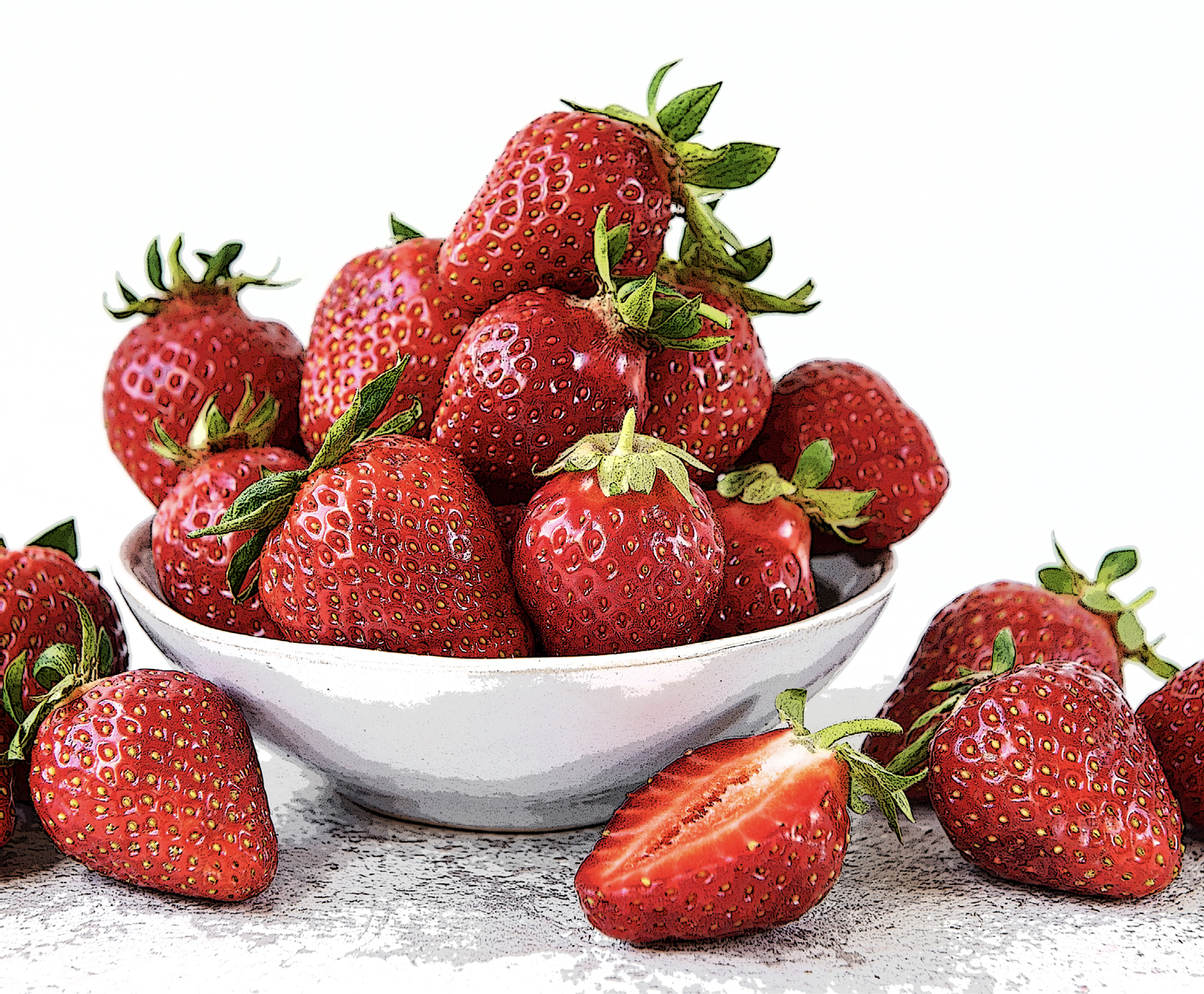
Susanne Fehlings
A Journey through Soviet and post-Soviet Plant Entanglements

PLANT PERSPECTIVES - 2025: 165–181
doi: 10.3197/whppp.63845494909753
Open Access CC BY 4.0 © The Author
ABSTRACT
This essay aims at unravelling Soviet and post-Soviet livelihoods and landscapes by looking at plant entanglements. It is about my own journey as an anthropologist and about leitmotifs I encountered across the post-Soviet space in almost two decades of fieldwork in Russia, Ukraine, Central Asia, and the Caucasus.
KEYWORDS
Caucasus, Central Asia, post-Soviet, fruit crops, food
 his essay aims at unravelling Soviet and post-Soviet livelihoods and landscapes by looking at plant entanglements. It is about my own journey as an anthropologist and about leitmotifs I encountered across the post-Soviet space in almost two decades of fieldwork in Russia, Ukraine, Central Asia and the Caucasus. It thus talks about hunger, abundance, ruins, imagined paradises, seduction and temperance; about beauty, survival, mobility, migration, conquest and destruction; and about plants in general and fruit crops in particular.
his essay aims at unravelling Soviet and post-Soviet livelihoods and landscapes by looking at plant entanglements. It is about my own journey as an anthropologist and about leitmotifs I encountered across the post-Soviet space in almost two decades of fieldwork in Russia, Ukraine, Central Asia and the Caucasus. It thus talks about hunger, abundance, ruins, imagined paradises, seduction and temperance; about beauty, survival, mobility, migration, conquest and destruction; and about plants in general and fruit crops in particular.
HUNGER AND ABUNDANCE
Two years ago, I participated in a meeting of anthropologists in Bolzano, Italy. The place was well chosen, as Bolzano was home to one of the founding fathers of modern anthropology, Bronislaw Malinowski, author of The Argonauts of the Western Pacific (1922). At this meeting, I had a table conversation with a colleague who had conducted fieldwork in Nigeria. He was very emotional about his experiences and told me how seeing starving children had changed his attitude toward food. He declared that he was disgusted by the fuss made about sophisticated cuisine, and he maintained the opinion that food was for nourishment – and that any other approach to nutrition was ridiculous and an immoral luxury. I was very much impressed by his words and afraid to order a dessert. His account made me ponder, and I started to compare my own completely different fieldwork experience with what he had said.
In my research area, the most terrible famines of recent history happened in early Soviet times. Between 1930 and 1933/34 an estimated 3.5 million people starved to death in Ukraine, more than 3 million in Russia, and more than 1.2 million in Kazakhstan. While historians do not fully agree on whether these famines were intentionally used by authorities to exercise power, the collectivisation of agriculture as part of Soviet policies clearly played a significant role in these disasters (Cameron 2018; Davies and Wheatcroft 2004; Graziosi 2015; Kuromiya 2008; Pianciola 2004; Rudnytskyi et al. 2020).
But although these famines, which were preceded and followed by other times of scarcity, have left traces in the collective memory of Soviet, post-Soviet, and post-post-Soviet people, I never felt that abundance, luxury or feasting of any kind was reprehensible in Russia, Ukraine, Central Asia, or the Caucasus. To the contrary, across post-Soviet Eurasia I observed the same ‘cult’: the veneration of good food – and of fruits, herbs, and vegetables in particular. These were always described to me as the most aromatic, the healthiest, and the most beautiful – if not on earth, then in the area – and I was urged to taste all of them . . . which I did shamelessly.

Figure 1.
Fruit assortment. All photos by the author.
A few weeks after my conversation in Bolzano I visited my colleague Togzhan in Merki. Merki is a very small Kazakh town at the foot of the Tian Shan Mountains, a five- to seven-hour ride from Almaty. It is very far away and different from Bolzano. But there are – nevertheless – some commonalities: complicated access routes, breathtaking landscapes and good conditions for growing apples. In fact, Kazakhstan is recognised as the cradle of apples, which had to travel a long way and undergo many adaptations before getting as far as South Tyrol and into strudel.
When I arrived in Merki, it was the last day of the spring festival Novruz and the beginning of Ramadan. I was immediately urged to participate in a banquet, and I felt I was back in the field: back to a familiar assortment of food that evokes so many associations; back to large bowls of fatty meat, potatoes, soup, plov, salads, herbs, bread, pastry, sweets and fruit; and back to all the stories that come with them.
RUINS AND STRAWBERRIES
The next day, Togzhan and I decided to visit the former local fruit-crop sovkhoz. Like the kolhoz, the collective farm, the sovkhoz, which was state owned, was a component of socialist agriculture and had to be reorganised – privatised or turned into a joint-stock arrangement – after the Soviet collapse. The sovkhoz of Merki was succeeded by an organisation called TOO Opythnoje Khosjastvo Merkenskii, which on that day was closed because of the holiday.
As in many other places in Central Asia and the Caucasus, the remnants of Soviet infrastructure in Merki present a sad picture. Buildings fell into ruins, the irrigation system crumbled, and former agricultural fields were transformed into barren lands. Looking at these relics makes me feel melancholy. They remind me of post-apocalyptic science fiction scenarios, where a few survivors try to extract resources from what was left behind by a past civilisation. I have seen many such places: public buildings, transportation facilities and industrial plants, reminders of a huge, enthusiastic, but failed attempt to implement a modernisation project that in Soviet times was imagined as heaven on earth.
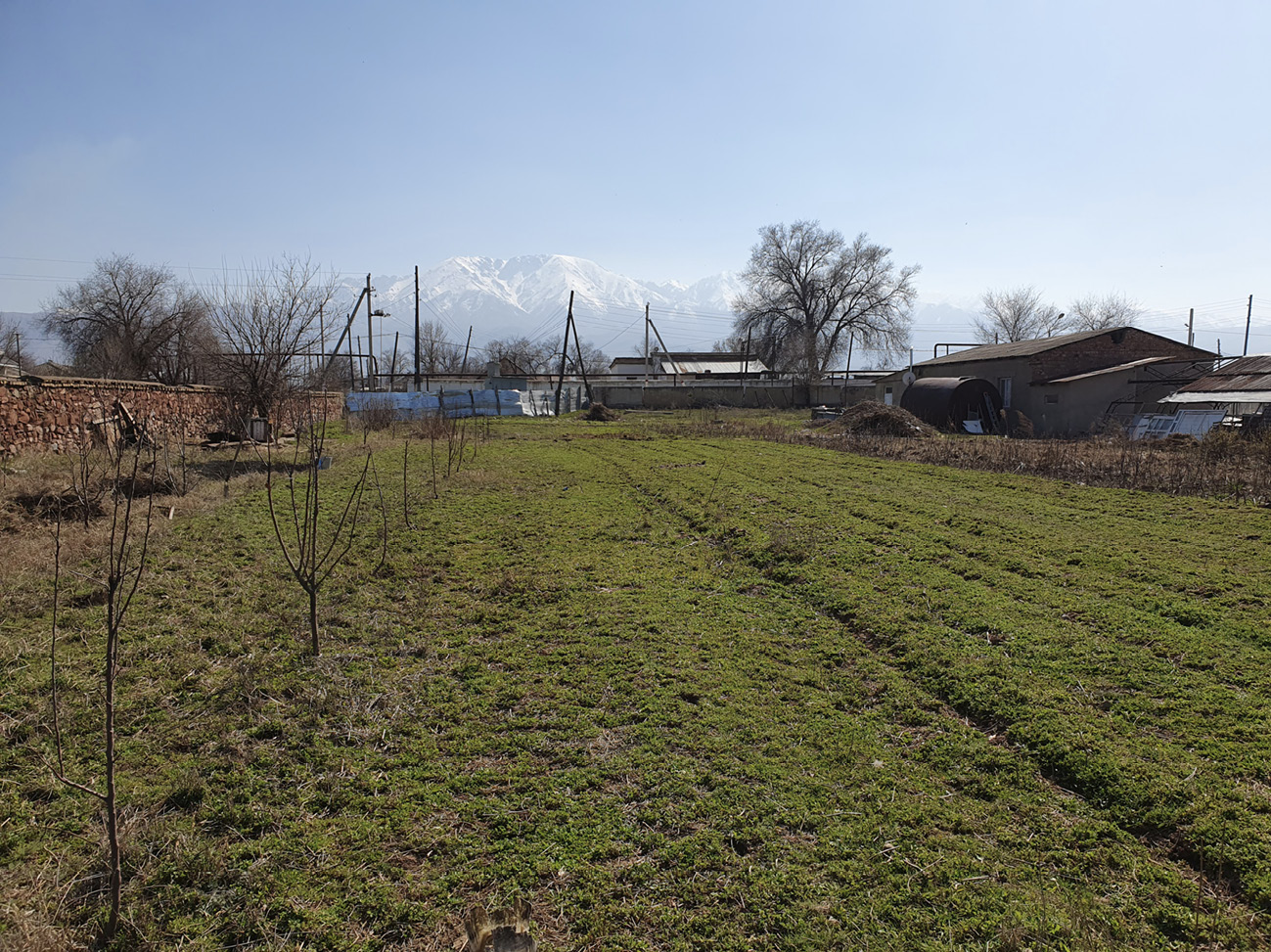
Figure 2.
Soviet Eden at the foot of the Tian Shan Mountain.
When Togzhan and I were strolling around on the former sovkhoz territory, we saw two people planting apple trees on a plot. The plot was surrounded by an ugly concrete wall and included the skeleton of an old greenhouse. Was this a survival of Soviet Eden, of paradise, of the socialist version of the biblical ‘enclosed garden’? We tried to get the attention of the planters, who finally invited us, the ridiculously hand-waving anthropologists, to enter through a squeaky metal gate.
Inside, the couple looked at us with curiosity and then showed us the apple trees and the work they did breeding and planting them. It turned out that this former sovkhoz territory was now their private plot, which they used for their own produce. Occasionally, they sold some of the young trees and surplus apples, but this was not enough to make a living yet. Most of the time the couple relied on the man’s modest income as a teacher and the woman’s job at the former sovkhoz. They now live in a former sovkhoz building, and although it was Ramadan, they invited us for lunch and covered the table with fruits and jams. They were especially proud of their homemade strawberry varenje, a juicy syrup-strawberry compound. As we were appropriately thrilled, the host told us a story of a Kazakh emigrant who had come back from America – very understandably so – just to eat these strawberries.
SEDUCTION AND APRICOTS
Such strawberry stories are very common in the post-Soviet space. Not all of them are about strawberries, of course. There is a Russian saying that more or less translates as ‘any place is better than the place where we live’ (vesgdje lutshe gdje nas njet). It expresses a general dissatisfaction of post-Soviet people with their living conditions, which never meet expectations, no matter where one ends up. Usually, this is about politics and society – at home or abroad. However, in contrast, wherever you go in post-Soviet Eurasia, there is apparently no better place to be for trying an edible species. As I witnessed many times, people become poets when describing the colours, textures, flavours and tastes of their harvest, and they have compassion for those poor people in the West, the poor Americans and Europeans, who will never see, feel, smell or try these culinary sensations.
The Armenian jazz musician Gary Kesayan, whom I got to know during my first fieldwork in Armenia in 2010, is such a fruit-and-vegetable poet and a gifted storyteller. He told me how, after the dissolution of the Soviet Union, he tried to make a career in the United States. Although he was successful at doing so, he missed his homeland – especially its tastes and flavours. When he returned to California after a holiday, he usually filled his suitcase with apricots. One day, the American airport customs dogs sniffed them out. The customs officer was all alert: he thought, as Gary reported with satisfaction, that the dogs had found drugs. Gary had to unpack his suitcase. He held the apricots under the officer’s nose, and the man was so enchanted and seduced that he wanted to taste them and let Gary pass.
The American customs officer is in good company. Throughout history, even gods and goddesses have been tempted by a variety of fruits. The pomegranate, for example, seduced Eve, whose apple was likely a pomegranate, Persephone, and – in a less mythical way – Gregory Levin. While Eve was chased from the Garden of Eden for trying the forbidden fruit, Persephone was tied up in Hades for six months each year because she ate six pomegranate seeds in the underworld (Frazer 1906–1915). Levin’s life was equally complicated – and a very Soviet one. Born in 1933, he survived the famine in besieged Leningrad, weathered the turbulence in Stalin-era academia, and finally, in the 1960s, became chairman of the laboratory of subtropical fruit cultures at the VIR Turkmen Agricultural Station in Carrigalla, Turkmenistan. Until the 1990s, he dedicated his life to pomegranates and created the largest pomegranate collection in the Soviet Union and worldwide. After the Soviet collapse, Levin shared the fate of many Soviet intellectuals: he became an emigrant and – as he had a Jewish background – moved to Israel, the holy land, which for him became a ‘botanist’s exile from Eden’ (Levin 2006).
Most Western European and American readers will hardly understand the kind of obsession and relationship with a fruit crop that drove Levin and that drives many people in Eurasia. Some Europeans were once obsessed with spices or stimulants like coffee, tea and tobacco (Dalby 2002; Schivelbusch 1990), but the relationship of Americans with the apple, for example, is a rather sober one. There is no exaltation of smells and tastes, no lavishness and Bacchanalia. If we believe Pollan (2001), what the American Protestant pioneers of the Western frontier liked about the apple was that the available varieties (unlike those in Bolzano and modern Kazakhstan) were unenjoyably sour. Drinking apple cider was no threat to pious modesty and simplicity. The pomegranate, by contrast, is the ultimate symbol of excessive luxury, cherished in local visual arts and handicrafts and sung about in traditional and contemporary fairy tales, poetry, and music.
SURVIVAL AND POMEGRANATES
In Armenia the pomegranate, along with the apricot, is (as in some parts of the Middle East and Asia) considered a national symbol. It grows in the wild and is cultivated in private gardens and on farms. It represents fertility, prosperity, abundance, life, and happiness, but also blood and death. It is associated with the Armenian Apostolic Church, whose numerous and diverse members are compared to pomegranate seeds, united under one rind, and the fruits are blessed in the New Year’s ritual and smashed at weddings, as the bursting seeds promise a wealth of children, husbandry and community (Stepanyan 2014). The pomegranate is thus associated with individual and collective survival, as is also reflected in stories about survivors of the Armenian Genocide who endured death marches to Syria by appeasing hunger1 with one pomegranate seed per day.
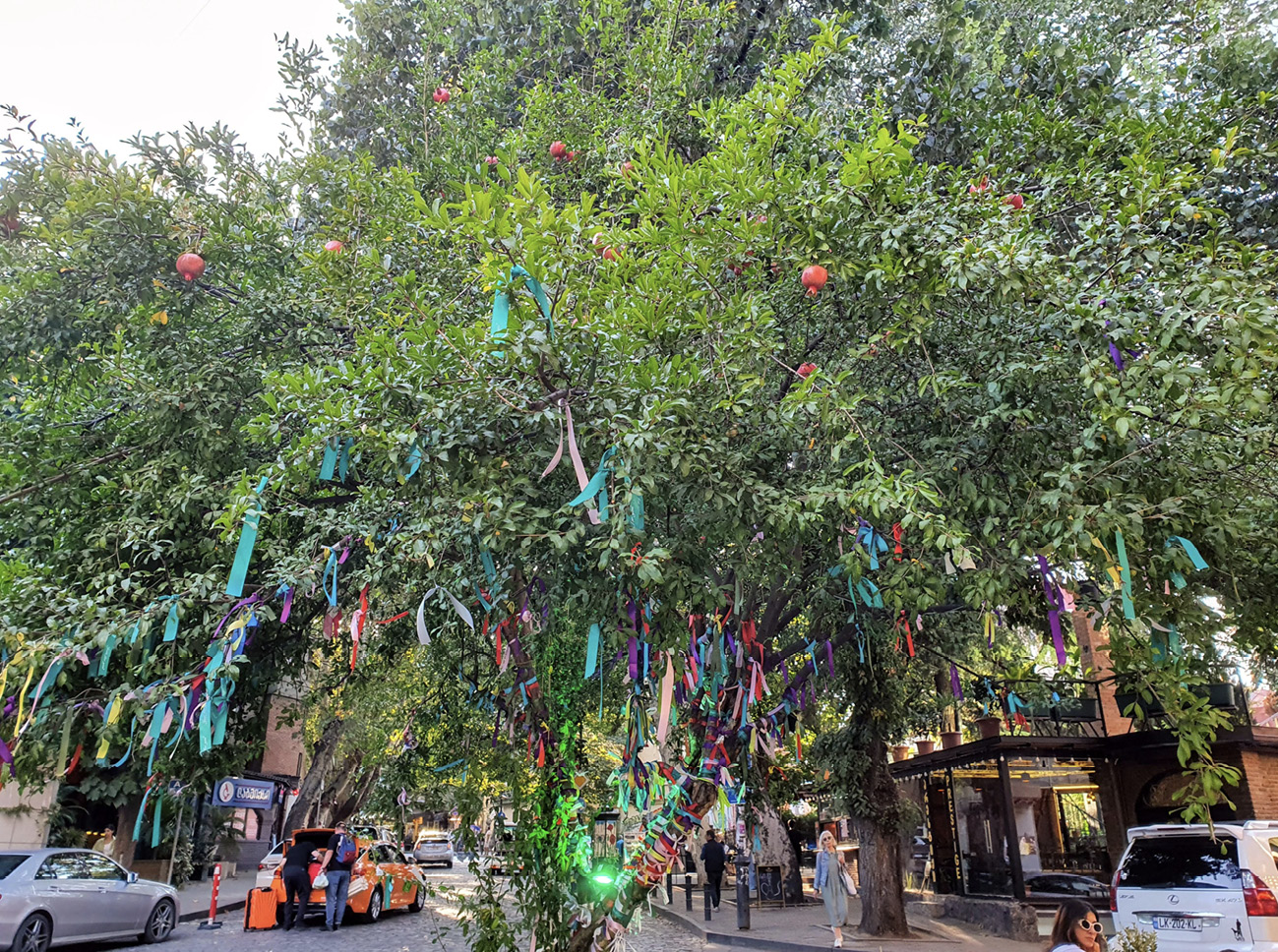
Figure 3.
Pomegranate wish tree in Tbilisi, Georgia.
Such accounts can be interpreted as parts of a powerful ‘mythico-history’ (Malkki 1995) that links modern Armenians to stories from the past, local customs and values, and agricultural and vegetal environments. Comparable roles are played by the apple in Kazakhstan, the walnut in Kyrgyzstan (Schmidt and Dörre 2011), and grapes in Georgia and Moldova (Regniez 2016). These crops are locally and translocally used as national, ethnic, and religious symbols, as objects of ritual practice and economic exchange, and as items of everyday consumption, extending beyond the boundaries of pre-Soviet, Soviet, and post-Soviet experiences and relationships.
In William Saroyan’s short story ‘The Pomegranate Trees’ (1940) the pomegranate is linked to Armenian diasporic identity. Saroyan, an Armenian American descendant of genocide survivors, tells the story of his uncle Melik, who bought a plot of land in the desert of the Sierra Nevada to grow pomegranates. After some struggles, lack of profit forces Melik to give up the orchard, and the trees tragically die. According to Stone (2017), the trees thus become a symbol of the ‘unattainable and unrealistic dream that will ultimately fail’ and an ‘image of beauty, but not productivity’.
From a rational point of view, indeed, the pomegranate is not the best choice to make a profit and secure one’s survival. Although the pomegranate has occasionally been labelled a ‘super food’ because of its anticarcinogenic urolithin content, its nutritional importance is rather small. Noah, the first farmer working the fertile post-Flood Ararat plain, was wise enough to cultivate vineyards instead. But Saroyan’s story – in my opinion – is not about economic gain. It is about beauty and a diasporic longing for the things left behind: customs, values, agricultural practices, and vegetal environments; it is about a feeling that is shared by many people in Eurasia who have lost their homes due to persecution, civil wars, deportation, systemic collapse, and economic reasons. Melik plants the orchard to establish a perfect environment and an alternative home, but because of the Californian cacti and desert plants, because of external forces in an alien environment, this desire cannot be satisfied. Home remains a paradise lost, migration an exile from Eden.
Still, fruit, be it pomegranates, grapes, or apricots, can bridge temporal and geographical distances, unite dispersed peoples and relate fragmented histories. Human-plant relationships tell us something about – sometimes hidden – global connections: about the bond between the homeland and diaspora and migrant communities and about the links between the past, present, and future.
CONQUEST AND GRAPES
In all eras, planting trees has always been a way to make a claim on land. Pioneers on the American frontier validated their claims by planting apple trees (Pollan 2001), and around 300 years earlier Hernán Cortés did something similar in Mexico using pomegranate trees (Stone 2017). From Mexico, eighteenth-century Spanish settlers brought the conquistadores’ pomegranates farther north to Texas, Arizona, and finally California, where in the twentieth century – just a funny coincidence – they were joined by Soviet cultivars from Turkmenistan. Seeing his lifetime achievements going to seed, Levin, the Soviet botanist, sent the varieties he had bred to the USDA National Clonal Germplasm Repository at the University of California, Davis (Levin 2006), from where they were distributed to American farmers – in a region that is home to the largest Armenian diaspora community in the United States, the place where Saroyan wrote his story about Melik.
Usually, however, plant entanglements have a less peaceful story to tell. Conquest and gardening are an ancient couple. Both result in the intentional and unintentional diffusion of plants by mobile people and individuals – conquerors, migrants, traders, and travellers. In the sixteenth and seventeenth centuries, Western colonisers, who perceived the local ecologies of their overseas colonies as a threat, started to transform ‘wilderness’ into European landscapes (as we can see in North America) (Gosh 2023) and, like the Assyrian emperors, thereby displayed their power and creative potency (Dalley 1999, 2013; Grayson 1996). In the ancient past until the Middle Ages, planting was considered a cosmic act of creation, and to this day, well-tended gardens and landscapes represent harmony, social order, and the victory of civilisation.
Starting in the 1920s, the Soviets planted representative parks, gardens and avenues of trees, which became part of urbanisation and modernisation projects. The Soviet approach was driven by Marxism, historical materialism, and a strong aspiration for modernisation, reflected in urbanisation projects: Bishkek in Kyrgyzstan, Almaty in Kazakhstan, Moscow in Russia, and many other cities in the Soviet republics received a new layout including a lot of civilised green space. In this spirit, chief architect and city planner Alexander Tamanyan implemented a master plan for Yerevan that transformed the former city of gardens into a model-like Garden City as proposed by Ebenezer Howard. The garden city provided good living conditions for the Soviet working class and embodied enthusiasm for societal change and progress (Ter Minassian 2007).
Alas, conquest and transformation have a dark side, too, and go along with destruction and cutting down trees. Since antiquity, cutting down olive trees has been an established method to destroy the enemy’s subsistence, and during the recent Karabakh War, Armenians who had to leave their homes cut down fruit trees on their properties before leaving them to their enemies.
The reasons for destroying plants can be manifold – sometimes seemingly absurd. Between 1985 and 1987, the Soviets eradicated hundreds of thousands of hectares of vineyards, just because wine made from grapes tastes better than frontier cider – with the consequence that the average Soviet male citizen of the 1980s lived twelve years fewer than his (Protestant or non-Protestant) American equivalent. Alcoholism was widespread and said to cause a loss of one third of Soviet agricultural production. Gorbachev’s radical anti-alcoholism campaign, which was successful but is remembered as a catastrophe by wine makers and consumers, attacked the roots of the problem: the vineyards in the Soviet republics of Moldova, Ukraine, and Georgia (Bhattacharya et al. 2013).
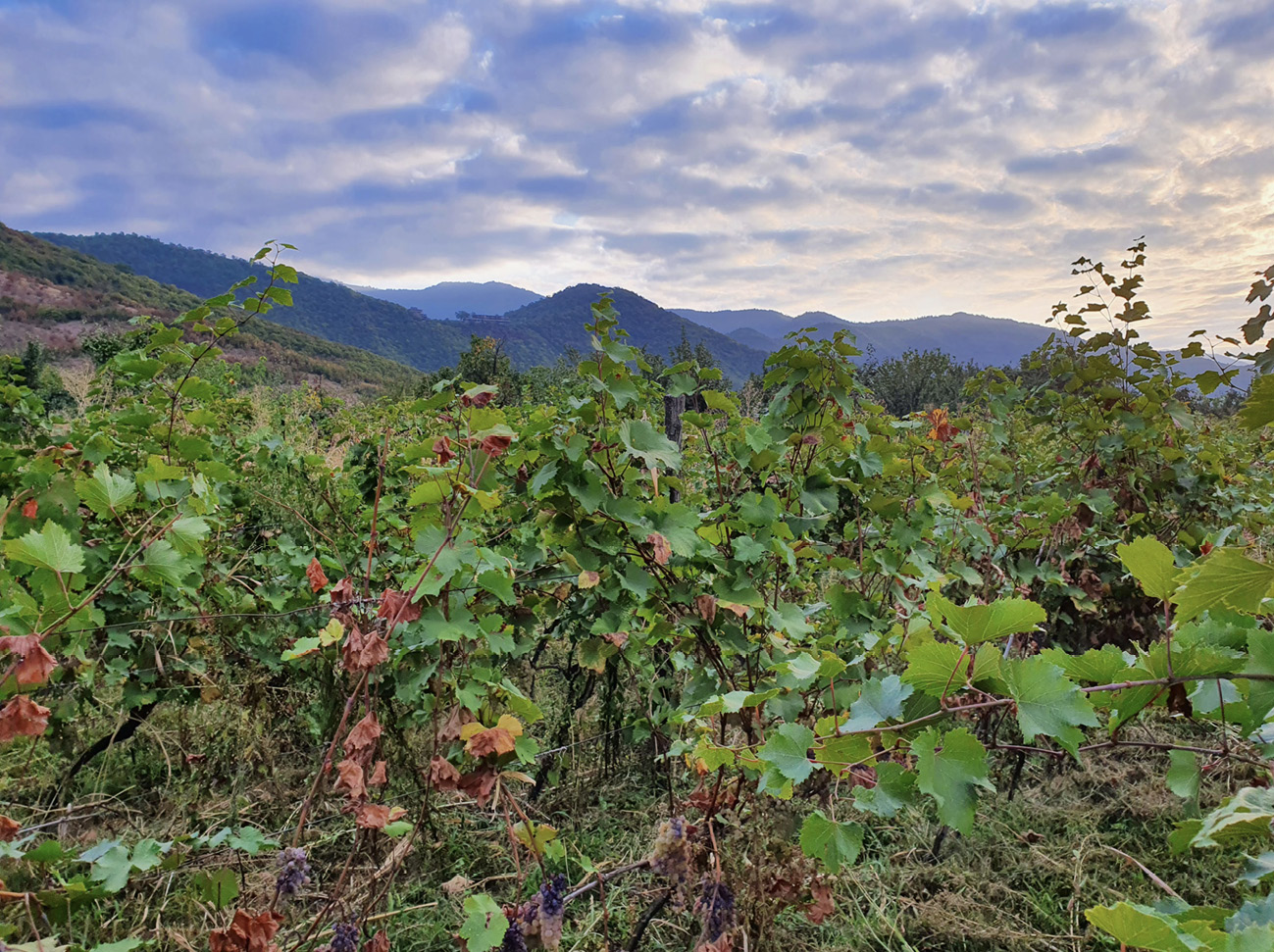
Figure 4.
My colleague’s vineyard in Kakheti.
One collateral victim of the campaign was Pavel Golodryga, another scientist like Levin, who had dedicated his life to the development of forty new grape varieties at the Maragach Scientific Research Institute of Viticulture and Winemaking in Yalta, Crimea. Golodryga, who earlier in his life was awarded the Order of the Red Banner of Labour, committed suicide.
Another desperate felling took place in the 1990s for a completely different reason. In these years, Soviet parks – including Yerevan’s greenbelts – fell prey to the need for firewood. This destruction of the ‘black years’ was interpreted as an ultimate symbol and climax of societal collapse. Ironically, the felling continued after the economic transition because of a new construction boom, which was a consequence of the neoliberal privatisation and commercialisation of public space. New elites and oligarchs across post-Soviet Eurasia started to invest in elite housing and got into fights over trees with environmentalists, protesters and residents (Gurchiani 2022).
Much of what happened in post-Soviet Eurasia can be expressed by talking about plants. In Tashkent the new elites planted conifers, which did not survive the Uzbek climate, and instead of replacing them, the dead trees were sprayed green to look attractive (Olma 2020). In Georgia, the oligarch Bdzina Ivanishvili had many old and impressive trees dug up to replant them in his semiprivate garden. In Armenia, the massive felling of trees in the city centre was countered by the Armenian Tree Project, a diaspora-sponsored NGO.
PASTS AND FUTURES
Both the Soviet legacy and the Soviet collapse cast long shadows. More than twenty years after the dissolution of the Soviet Union, my colleague Louise observed the mass extinction of apple trees in the Kyrgyz countryside. These trees had been gifted to farmers by the Soviet government and now, after some decades, had reached the end of their lifespan, their death being a symbol of the redemption of Soviet rule.
Eurasian viticulture, on the other hand, has come back to its ancient glory, at least in Georgia, where the production and the ritual (and profane) consumption of wine are seen as part of the national identity. A few months before my journey to Bolzano and then to Kazakhstan I travelled to Georgia for a short fieldwork trip. Much had changed since my previous stay. People now talked about the war in Ukraine, Georgia’s position with regard to Russia, and the influx of Slavic newcomers. My friends and colleagues expressed anxiety, dissatisfaction with their own government, and anger that Georgia had not been granted European Union candidacy status.
The purpose of my visit was to find out how the Covid-19 pandemic had impacted local shuttle and bazaar trade – but, somehow, I ended up harvesting grapes in my colleague’s vineyard in Kakheti. There, I worked side by side with his huge family and the young women who usually work in his sister-in-law’s beauty salon. The women, including myself, cut the grapes, while the men loaded the harvest on a trailer. There was a lot of teasing, chatting, and flirting, and by 10 a.m. everyone was exhausted. Under the beating sun and by the sweat of our brow we had picked 2.5 tons of grapes.
A small part of the harvest was crushed in a wooden trough and poured into a traditional qvevri, a huge clay amphora almost completely buried in the ground, which had been excavated under a house from the 1970s and had thus proven to be earthquake resistant. Accompanied by singing and music, my colleague’s daughter, the youngest participant, was allowed to start stomping and was then joined by other women. The first juice, according to protocol, was served to the grandmother, the oldest participant, thus continuing local traditions that might originate in the pre-Soviet past. She praised ex-president Saakashvili and made some toasts wishing that unmarried people present would get married and that the current government would be hung on the nearest tree. Then, modern technology – an automatic baler – took over, while people prepared for a lavish traditional Georgian supra, a banquet and feasting ritual.
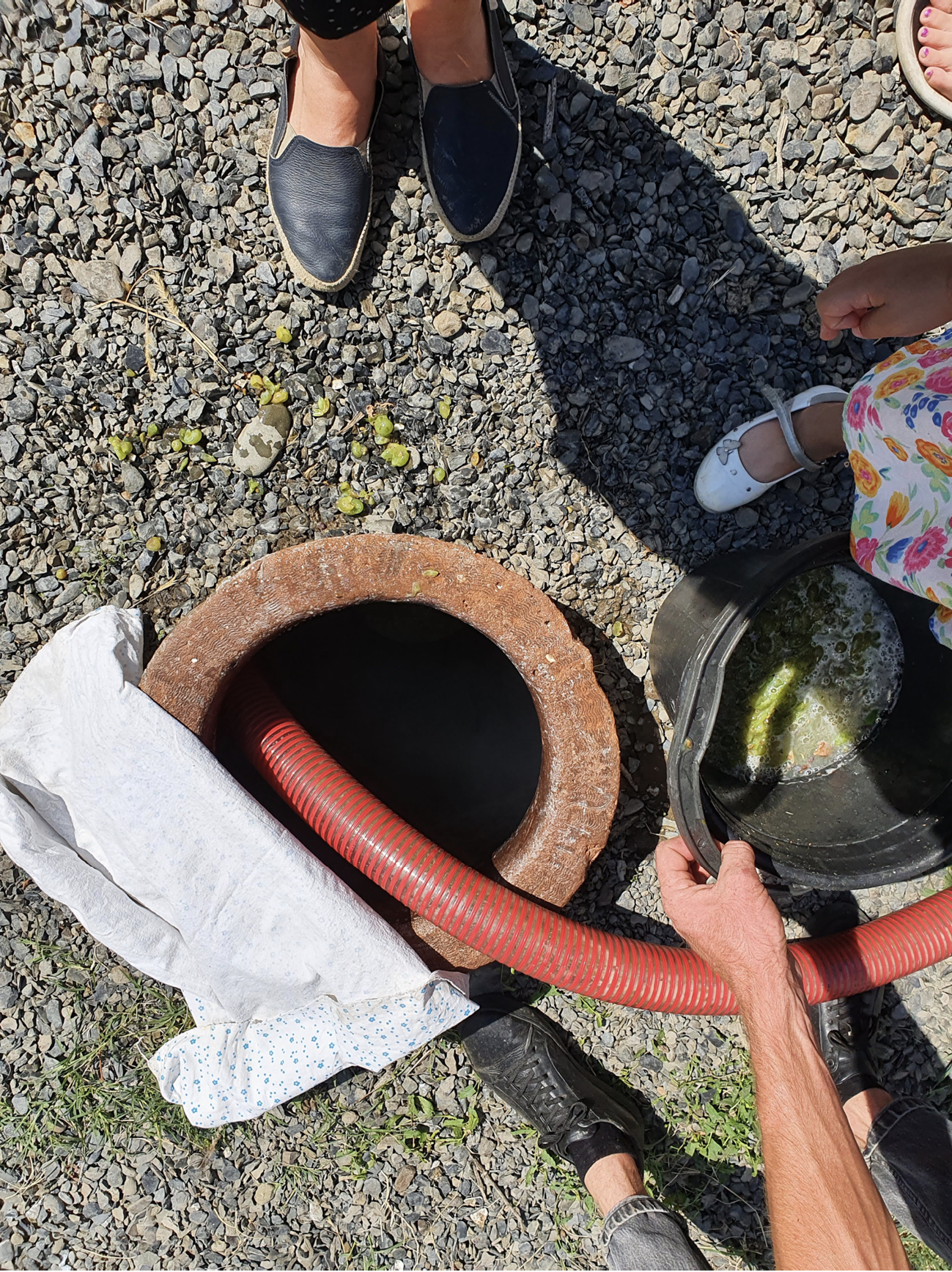
Figure 5.
Quevri.
After a short ride, we gathered at tables scattered along a brook in a small forest at the edge of a monastery. We had shashlik, fruit, a lot of wine, toasts, dancing, and singing. We celebrated the unchanging rhythms of life. At nightfall, the dogs, who had been strolling around all day, gathered into a pack and attacked. They jumped on the table and stole the food. Although nobody was hurt, there was panic, and while the dogs were distracted, the human party flew to their cars and hit the road back home.
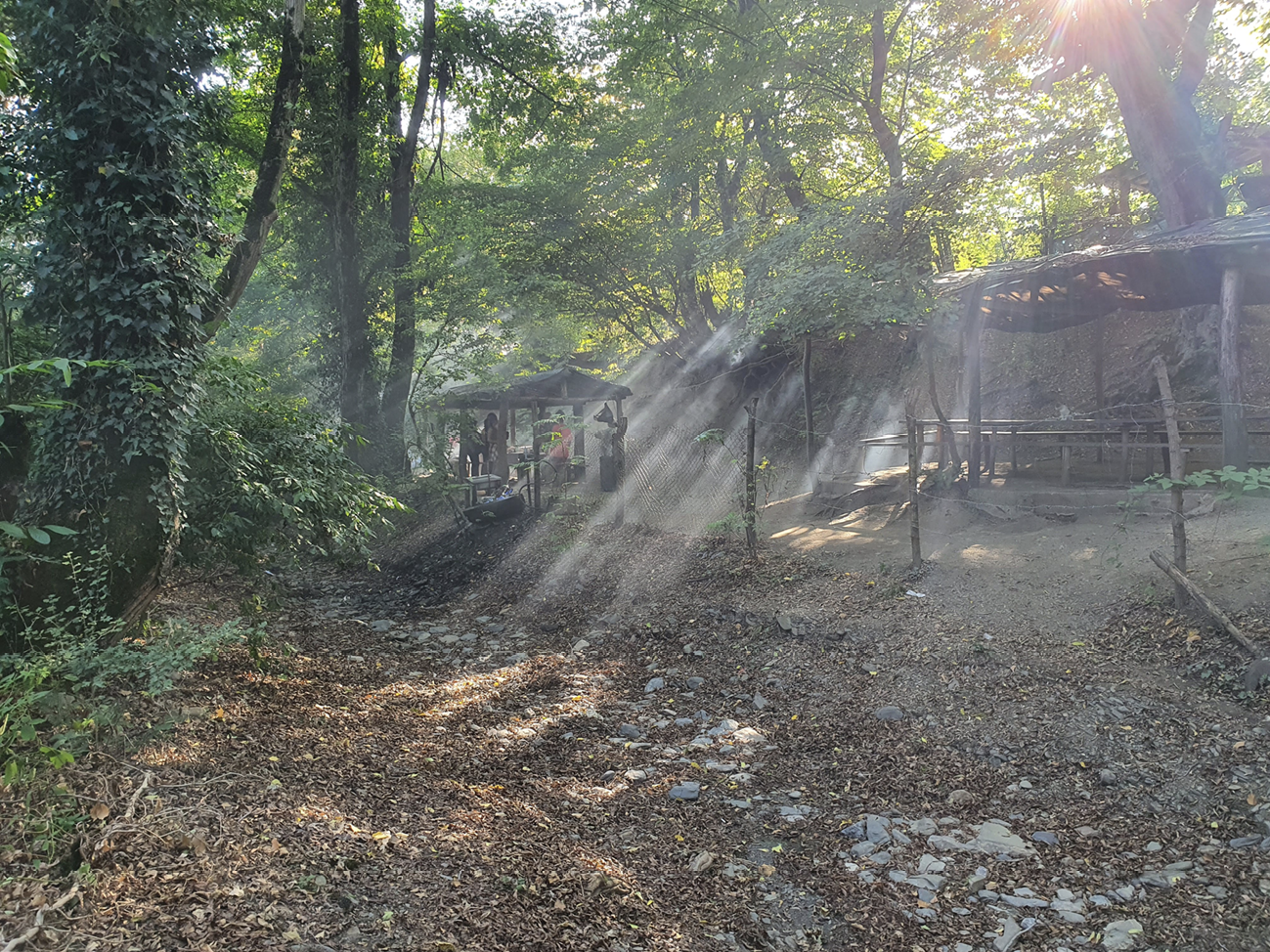
Figured 6.
Before nightfall.
References
Bhattacharya, J., C. Gathmann and G. Miller. 2013. ‘The Gorbachev anti-alcohol campaign and Russia’s mortality crisis’. American Economic Journal: Appplied Economics 5 (2).
Cameron, S.I. 2018. The Hungry Steppe: Famine, Violence, and the Making of Soviet Kazakhstan. Ithaca: Cornell University Press.
Dalby, A. 2002. Dangerous Tastes: The Story of Spices. Los Angeles: University of California Press.
Dalley, S. 1993. ‘Ancient Mesopotamian gardens’. Garden History, the Journal of the Garden History Society 21.
Dalley, S. 2013. The Mystery of the Hanging Garden of Babylon: An Elusive World Wonder Traced. Oxford: Oxford University Press.
Davies, R. W. and St. G. Wheatcroft. 2004. The Years of Hunger: Soviet Agriculture, 1931–1933. Basingstoke: Palgrave Macmillan.
Frazer, J.G. 1906–1915. The Golden Bough (Third Edition): A Study in Magic and Religion. London: Macmillan and Co.
Gosh, A. 2023. Der Fluch der Muskatnuss. Berlin: Matthes und Seitz.
Grayson, A.K. 1996. Assyrian Rulers of the Early First Millennium BC (1114–859 BC). Toronto: University of Toronto Press.
Gurchiani, K. 2022. ‘Die verborgene Macht der Bäume. Urbaner Widerstand in Tiflis’. In F. Sutterlüty and A. Poppinga (eds). Verdeckter Widerstand in demokratischen Gesellschaften. Frankfurt am Main: Campus Verlag.
Kuromiya, H. 2008. ‘The Soviet Famine of 1932–1933 reconsidered’. Europe-Asia Studies 60 (4): 663–75.
Levin, G. 2006. Pomegranate Roads: A Soviet Botanist’s Exile from Eden. Forestville: Floreant Press.
Malinowski, B. 1922. Argonauts of the Western Pacific: An Account of Native Enterprise and Adventure in the Archipelagoes of Melanesian New Guinea. London: G. Routledge & sons.
Malkki, L.H. 1995. Purity and Exile: Violence, Memory, and National Cosmology among Hutu Refugees in Tanzania. Chicago & London: The University of Chicago Press.
Olma, N. 2020. ‘Urban Ruins: Of Tashkent’s trees, old-timers, and newcomers’. Theorizing the Contemporary, Fieldsights 24 March: https://culanth.org/fieldsights/urbane-ruins-of-tashkents-trees-old-timers-and-newcomers
Pianciola, N. 2004. ‘Famine in the steppe: The collectivization of agriculture and the Kazak herdsmen, 1928–1934’. Cahiers du monde russe 45 (1/2): 137–92.
Pollan, M. 2001. The Botany of Desire: A Plant’s-Eye View of the World. New York: Random House.
Regniez, P. 2016. Au pays de la vigne et du vin, la Géorgie. Paris: éditions des Indes Savantes.
Saroyan, W. 1940. ‘The pomegranate trees’. In W. Saroyan, My Name is Aram. San Diego: Harcourt Brace.
Rudnytskyi, O., St. Kulchytskyi, O. Gladun and N. Kulyk, N. 2020. ‘The 1921–1923 famine and the holodomor of 1932–1933 in Ukraine: Common and distinctive features’. Nationalities Papers 48 (3): 549–68.
Schivelbusch, W. 1990. Das Paradies, der Geschmack und die Vernunft: Eine Geschichte der Genußmittel. Frankfurt am Main: Fischer.
Schmidt, M. and A Dörre. 2011. ‘Changing meanings of Kyrgyzstan’s nut forests from colonial to Post-Soviet Times’. Area 43 (3): 288–96.
https://doi.org/10.1111/j.1475-4762.2010.00988.x
Shirinian, G. N. 2017. ‘Starvation and its political use in the Armenian Genocide’. Genocide Studies International 11 (1): 8–37.
Stepanyan, N. 2014. ‘Pomegranate: Multitude in unity’. In G. Parolly, K. Grotz and W. Lack (eds), Caucasus: Plant Diversity between the Black and Caspian Seas, pp. 111–13. Berlin: Botanischer Garten und Botanisches Museum Berlin-Dahlem.
Stone, D. 2017. Pomegranate: A Global History. London: Reaktion Books.
Ter Minassian, T. 2007. Erevan: la construction d’une capitale à l’époque soviétique. Rennes: Presses Universitaires de Rennes.
Susanne Fehlings studied anthropology, archaeology and art history in Tübingen, Paris and Moscow, and has conducted fieldwork in Central Asia, the Caucasus and Ukraine since 2007. She currently works as a senior researcher at the Frobenius Institute for Research in Cultural Anthropology, and holds the position of apl. professor at the Institute for Social and Cultural Anthropology at the Goethe University Frankfurt am Main. Her research interests include topics of economic anthropology, the anthropology of the state, urban anthropology and human–plant relations in Eurasia.
Email: susanne.fehlings@gmail.com
1 For the role of starvation during the Armenian Genocide see Shirinian (2017).